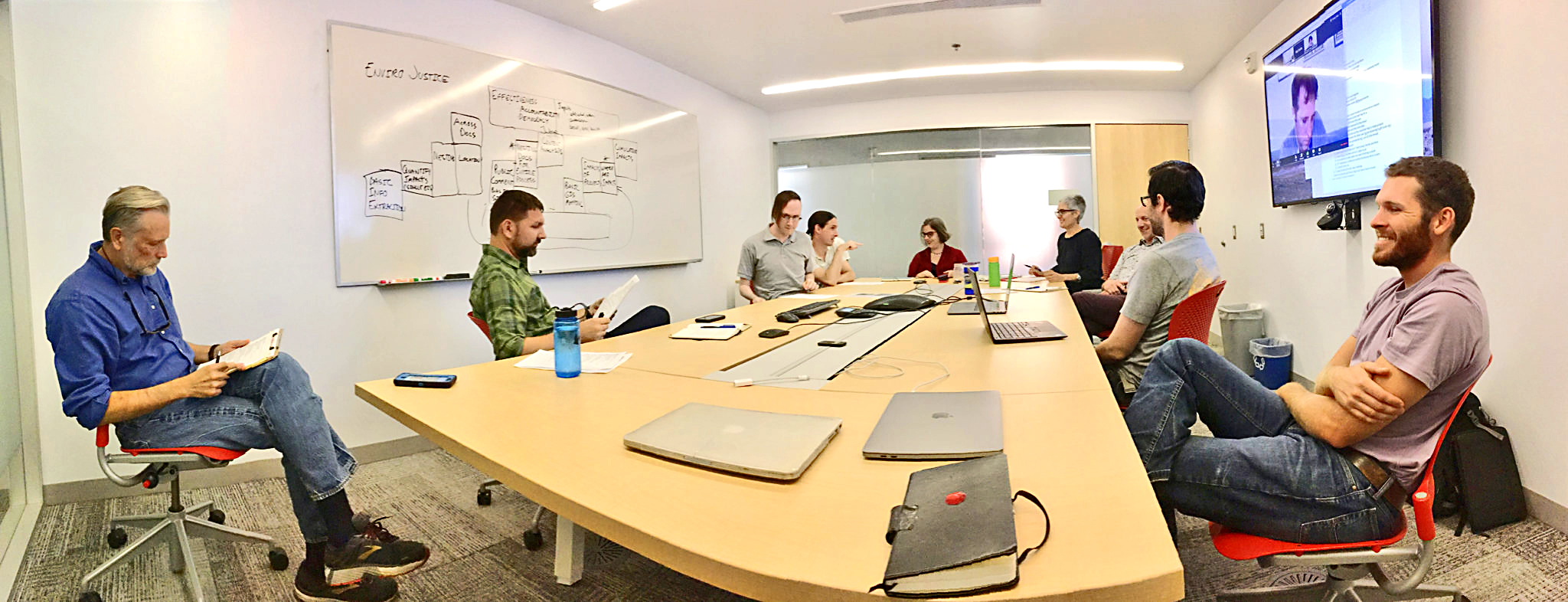About the NEPAccess Project

Table of Contents
We use the tools of data science and AI to improve the efficiency, transparency, and accountability of environmental decision-making.
Project overview
Under the federal Infrastructure Act of 2021, trillions of dollars are projected to be spent on the nation’s infrastructure; since all related projects must undergo NEPA review, an efficient, transparent, and accountable process is critical. In practice, the NEPA environmental review process is widely viewed as time-consuming, providing little accountability for decisions, and lacking a system to track impacts. To date, there is no standard protocol for reporting analyses and no centralized governmental source for finding NEPA documents and data.
That’s where NEPAccess comes in.
Supported by a 2018 grant from the National Science Foundation (#1831551), the University of Arizona’s NEPAccess team used AI and data-science tools to create a powerful cross-agency NEPA knowledge-discovery platform. With the development of our beta platform (2018-2023) we invited the public to find and analyze decades of applied science and records of public participation generated by NEPA in U.S. environmental decision-making processes.
NEPAccess beta, 2018-2023 was designed to improve efficiency, transparency, and accountability of the NEPA process by providing public access to environmental impact assessments (EIAs), extracting and delivering customized documents and datasets using machine learning and AI, and identifying key relationships between agencies, projects, and documents.
In phase 2, the NEPAccess team is eager to expand the project’s reach and impact.

The NEPAccess team in an early strategy session, Sept 2019
Project rationale and next steps
Defining the Problem
NEPA’s environmental review process is seen by some as time-consuming, failing to provide accountability for decisions, and lacking a system to track impacts. Agencies produce thousands of detailed and expensive environmental reviews under NEPA, but:
- There are no standard protocols for reporting analyses, data, public engagement, and environmental justice impacts.
- There is no centralized source for these documents and data.
For agencies and project proponents, this means:
- With each new project, they’re reinventing the wheel and not learning from the scientific studies conducted for past projects.
- Not everyone is working from the same set of information.
- They’re not sure they’re reaching the public or effectively assessing public concerns.
- It’s difficult to assess cumulative effects on people and the environment without data from past projects.
For the public:
- There is no accountability for environmental justice.
- They cannot be certain that their comments and engagement make a difference.
Urgency
Improving the efficiency, transparency, and accountability of NEPA today is vital for an environmentally sustainable future.
- The $1.2 trillion investment in the 2022 Infrastructure Bill is transforming the US on a scale not seen since the New Deal and the post-World War II building boom.
- Each new project will have to undergo a NEPA review.
- Data science-driven approaches to planning and reviewing these projects efficiently and effectively are urgently needed.
- A socially and environmentally equitable future requires transparent, engaged, and accountable environmental review processes.
What people are asking for
Major project stakeholders (including partner agencies, consultants, landowners, industry, researchers, and the public) want:
- Easy access to EIAs (environmental impact assessments) – no matter the lead agency.
- More efficient drafting of EIAs.
- A centralized portal to review and analyze cross- agency documents and public comments.
Agency officials and decision-makers want:
- Analytics on the time efficiency and effectiveness of the “business” of NEPA.
Scientists want:
- To unlock the vast publicly funded network of environmental knowledge held within NEPA review documents.
NEPAccess Solutions
NEPAccess is making this a reality. Our University of Arizona team of researchers, data scientists, and students uses the tools of data science and AI to unify environmental policy data previously dispersed across federal agencies. This makes possible immediate and radical improvements to the efficiency of NEPA processes and the production of better- informed, environmentally equitable outcomes.
- Provided unprecedented public access to the knowledge contained in environmental impact statements.
- Uses machine learning and AI to extract and deliver customized documents and datasets.
- Includes powerful tools to discover relationships – including temporal and geographic – in the networks connecting agencies, projects, and documents.
With additional funding, the NEPAccess of tomorrow will:
- Offer business analytics tools to support agencies and evaluate NEPA processes and outcomes.
- Use “Smart Scoping” and other retrieval-augmented generative AI tools to allow:
- Rapid synthesis
- Learning from past projects
- AI writing assistance for specific topics, e.g., scoping, proposed alternatives, monitoring, and mitigation
- Expand our dynamic, centralized, public portal over the network of knowledge in environmental policy documents.
- Ensure justice and accountability of decision-making through data standards, mapping and visualization of impacts and benefits to communities.
-
Support a more efficient, transparent, and accountable NEPA engagement for all stakeholders.
An Arizona NEPA preparer on why NEPA is a data science problem:
“Finding NEPA documents is like detective work… These agency sites are not very user-friendly, and you get a lot of non-relevant results, or no results at all. And so you can’t be sure you haven’t missed something important. … It takes a lot of time and duplicative effort.”
Impact
NEPAccess (beta) is already saving time, effort, and money.
- Arizona-based mining consultant: “Finding and reviewing past project examples [with NEPAccess] takes minutes instead of hours spent emailing colleagues of information and weeks spent waiting for responses.”
- Arizona-based DoD NEPA preparer: “With NEPAccess, writing my next EIA will take 2-6 months less time.”
Research using NEPAccess is already bringing the scientific method to bear on law and decision-making. Research papers in review and preparation:
- “Public Comments Matter: A Quantitative Study of Public Engagement in the NEPA Process.”
- “Explaining and Predicting the Efficiency of the NEPA Review Process.”
- “Why NEPA Needs Cost Accounting: Cost-Benefit Analysis of the National Environmental Policy Act.”
- “Are Agencies Getting Environmental Justice Right Within NEPA?”
Next steps
The NEPAccess team maintains our commitment to fulfill NEPA’s promise through the power of data science and AI. We are currently seeking funding and partnerships to expand the project’s reach and impact in our next phase.
Learn about our plans for NEPAccess 2.0.



